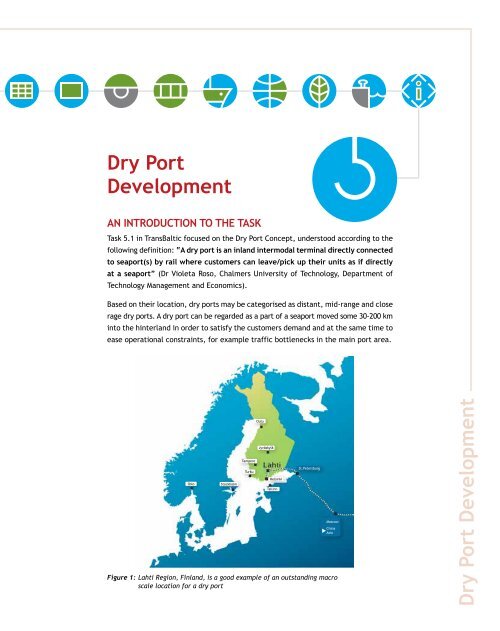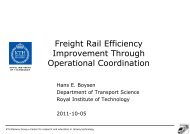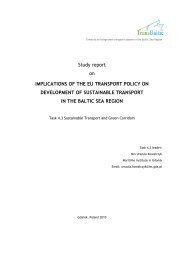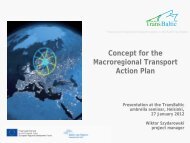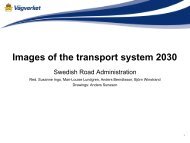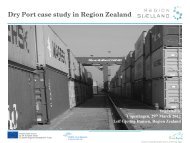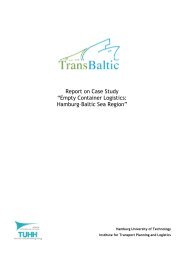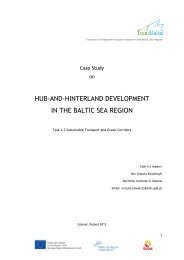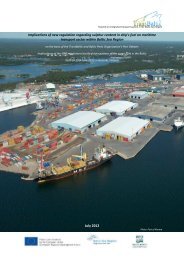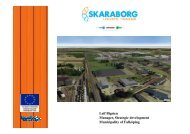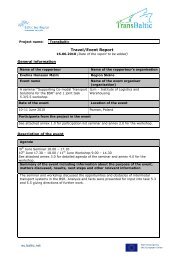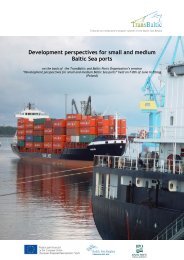Dry Port Development Dry Port Development - TransBaltic
Dry Port Development Dry Port Development - TransBaltic
Dry Port Development Dry Port Development - TransBaltic
Create successful ePaper yourself
Turn your PDF publications into a flip-book with our unique Google optimized e-Paper software.
<strong>Dry</strong> <strong>Port</strong><br />
<strong>Development</strong><br />
An introduction to the task<br />
Task 5.1 in <strong>TransBaltic</strong> focused on the <strong>Dry</strong> <strong>Port</strong> Concept, understood according to the<br />
following definition: “A dry port is an inland intermodal terminal directly connected<br />
to seaport(s) by rail where customers can leave/pick up their units as if directly<br />
at a seaport” (Dr Violeta Roso, Chalmers University of Technology, Department of<br />
Technology Management and Economics).<br />
Based on their location, dry ports may be categorised as distant, mid-range and close<br />
rage dry ports. A dry port can be regarded as a part of a seaport moved some 30-200 km<br />
into the hinterland in order to satisfy the customers demand and at the same time to<br />
ease operational constraints, for example traffic bottlenecks in the main port area.<br />
Oslo<br />
Stockholm<br />
Tampere<br />
St.Petersburg<br />
Moscow<br />
China<br />
Asia<br />
Figure 1: Lahti Region, Finland, is a good example of an outstanding macro<br />
scale location for a dry port<br />
Turku<br />
Oulu<br />
Jyväskylä<br />
Helsinki<br />
Tallinn<br />
▲<br />
<strong>Dry</strong> <strong>Port</strong> <strong>Development</strong>
The dry port concept is very applicable to the BSR conditions as several container ports<br />
around the Baltic Sea encounter problems with the lack of space, queuing times, road<br />
access and low share of rail transport mode in cargo supply. For that reason dry ports,<br />
located in the proximity to TEN-T links, could offer an additional capacity to the container<br />
ports. At the same time, the dry port concept offers hinterland regions the possibilities<br />
to improve their logistics competitiveness, create jobs and reduce transport costs as<br />
well as CO2 emissions.<br />
There is lack of an overall experience across the BSR in using this concept in practice<br />
as a driver for regional development. One of the main purpose of the <strong>TransBaltic</strong> Task<br />
5.1 was thus to test the suitability of the dry port concept in several areas around the<br />
BSR based on the voiced interest of some project partners. The WP 5.1 task has been<br />
led by the Finnish <strong>TransBaltic</strong> partner LAKES - Lahti Regional <strong>Development</strong> Company.<br />
The following <strong>TransBaltic</strong> partners actively participated in the task work: Region Skåne,<br />
Region Västerbotten, Västra Götaland Region, Region Sjælland, ILIM - The Institute of<br />
Logistics and Warehousing, Self-government of the Warmisko-Mazurskie Voivodship and<br />
Hamburg <strong>Port</strong> Authority. Associated partners representing logistics service providers,<br />
trade and industry were very active.<br />
The dry port implementation process is not defined and the implementation path is not<br />
generally known. There are no established roles how different stakeholders (EU, State,<br />
Region, Municipality, terminal operator, transport operators, customs) should share the<br />
risk in the <strong>Dry</strong> <strong>Port</strong> Implementation. Many times a dry port is seen as a regular hinterland<br />
terminal/warehouse business, where the terminal operator should take the risk – sometimes<br />
including the needed infrastructure investments, like railway link to the main<br />
railway line. The difference of a dry port and a regular hinterland terminal is not always<br />
seen. The dry port concept is defined although the definition is not very widely known:<br />
▼<br />
Adry port is an inland intermodal terminal directly connected<br />
to seaport(s) by rail where customers can leave/pick up<br />
their units as if directly at a seaport. “As if directly at the seaport”<br />
is a very crucial part of the definition, because it implies<br />
a certain level of integration with seaports as well as availability<br />
of services that may be found at a seaport, such as storage,<br />
maintenance of containers, customs clearance, etc. Therefore,<br />
dry ports are used much more consciously than conventional<br />
inland terminals, with the aim of improving the situation<br />
resulting from increased container flows, and a focus on security<br />
and control by the use of information and communication<br />
systems. Scheduled and reliable high-capacity transportation<br />
to and from the seaport is essential and determines the dry<br />
port’s performance and its environmental role. Based on their<br />
function and their location, dry ports may be categorised<br />
as distant, mid-range and close. (Dr Violeta Roso, Chalmers<br />
University of Technology, Department of Technology Management<br />
and Economics)<br />
<strong>Dry</strong> <strong>Port</strong> <strong>Development</strong><br />
Background & challenges<br />
The case of dry port development is very different to seaport development. Management<br />
routines in the seaport development tend to be established; all stakeholders are familiar<br />
with their roles and are usually eager to fulfill it:<br />
• The EU has policies and instruments: TEN, Motorways of the Seas, interest to<br />
develop ports as a part of the trans-European transport network, and offers financial<br />
support for the investments.<br />
• EU member states are in many cases financing/participating in the development of<br />
the port infrastructure or at least providing the transport infrastructure (road, rail,<br />
sea fairways) connecting to the port.<br />
• Cities and municipalities are usually acting as landlords, and are often very eager to<br />
develop the ports in their area and finance the infrastructure expansions. Municipalities<br />
are aware of the positive economic impact and jobs generated by the sea<br />
ports. In some cases, municipalities or a region around the port even at least partly<br />
owns the terminal operating in the port.<br />
• Companies running as the terminal operators invest in superstructure and actively<br />
manage, promote and develop the port terminal.<br />
• Customs has a clear role, legislation and custom codex developed for the port<br />
operations.<br />
• Transport operators (road and rail as well as shipping lines) have good practices and<br />
interest to develop the operations.<br />
<strong>Dry</strong> <strong>Port</strong> <strong>Development</strong>
Objectives<br />
Being aware of the challenges mentioned above, several <strong>TransBaltic</strong> partners decided<br />
to explore the dry port concept and analyse capacities for dry port implementation<br />
in their geographical area. The task started with four active sites: Swedish region of<br />
Västerbotten, Polish region of Warmia-Mazury, port of Hamburg and Finnish region<br />
around Lahti. However, in the course of the action, some additional partners decided<br />
to join the task in order to make some dry port feasibility analyses: Region Skåne,<br />
Region Sjælland and ILIM - The Institute of Logistics and Warehousing. The growing<br />
interest of the <strong>TransBaltic</strong> partners is a clear indicator showing the viability of the<br />
shippers<br />
port road City<br />
shippers<br />
port dry port road rail<br />
We can find examples where the dry port implementation has led to operational cost<br />
savings, opened new markets, improved economic activities and reduced CO 2<br />
emissions<br />
(see Fig. 2 below).<br />
City<br />
dry port concept. In addition to the local dry port studies, Task 5.1 had also more<br />
general purpose to give recommendations how the dry port concept implementation<br />
could be accelerated in the Baltic Sea Region.<br />
Distant Midrange Close<br />
Seaports • Less congestion • Less congestion • Less congestion<br />
• Expanded hinterland • Dedicated trains • Increased capacity<br />
• Interface with hinterland • Depot • Depot<br />
• Interface with hinterland • Direct loading ship-train<br />
Key Activities<br />
The process and key activities in the task implementation are shown below.<br />
Seaport • Less road congestion • Less road congestion • Less road congestion<br />
cities • Land use opportunities • Land use opportunities • Land use opportunities<br />
<strong>TransBaltic</strong> WP 5.1 <strong>Dry</strong> <strong>Port</strong> <strong>Development</strong><br />
<strong>Dry</strong> <strong>Port</strong> <strong>Development</strong><br />
Rail • Economies of scale • Day trains • Less time in congested<br />
operators • Gain market share • Gain market share road terminals<br />
• Avoiding environ -<br />
mental zones<br />
Road • Less time in • Less time in • Less time in<br />
operators congested roads congested roads congested road<br />
and terminals and terminals terminals<br />
• Avoiding environmental<br />
zones<br />
Shippers • Improved seaport • Improved seaport • Improved seaport<br />
access access access<br />
• Environment marketing • Environment marketing<br />
Society • Lower environmental • Lower environmental • Lower environmental<br />
access access impact<br />
• Job opportunities • Job opportunities • Job opportunities<br />
• Regional development • Regional development<br />
Figure 2: Description of freight flows without and with a dry port and a dry port typology<br />
(Dr Violeta Roso)<br />
In theory, many logistics stakeholders seem to agree with the potential benefits of<br />
dry ports. At the same time, in practice they are not confident an active role in the<br />
dry port implementation would bring them profitability. One of the main reasons<br />
for such perception is that the way the investment, risk and profit should be shared<br />
between stakeholders involved remains unclear.<br />
Dissemination of<br />
the <strong>Dry</strong> <strong>Port</strong><br />
Concept definition<br />
and benefits<br />
Study the <strong>Dry</strong> <strong>Port</strong><br />
Implementtation<br />
process, existing<br />
<strong>Dry</strong> <strong>Port</strong>s in<br />
Europe<br />
▼ ▼<br />
▼<br />
Plan and perform<br />
the <strong>Dry</strong> <strong>Port</strong><br />
Demonstrations<br />
Evaluate <strong>Dry</strong> <strong>Port</strong><br />
demonstrations<br />
EXISTING DRY PORT KNOWLEDGE, DRY PORT CONCEPT DEFINITION<br />
Figure 3: The dry port development process and activities in the <strong>TransBaltic</strong> project (Task 5.1)<br />
Summing up<br />
Dissemination<br />
▼<br />
▼<br />
<strong>Dry</strong> <strong>Port</strong> <strong>Development</strong>
Task 5.1 started with a comparative review of existing dry port experience and the<br />
dry port implementations. This knowledge – both theoretical and practical – was<br />
distributed to the <strong>TransBaltic</strong> partners and associated industrial stakeholders through<br />
organised seminars. Main topics addressed were:<br />
• what are the benefits per actor (consignor/consignee, shipping line, port, port<br />
terminal, forwarder, road and rail operator, municipality) and how soon the benefits<br />
can be reached after the implementation (economical, operational, other impacts);<br />
• what are the needed actions of involved stakeholders during the implementation stage;<br />
• who should lead the establishing stage of a dry port facility;<br />
• what kind of total budget is needed for the establishing stage, how big is the economic<br />
risk, how the risk should be shared;<br />
• what is the minimum annual turnover volume;<br />
• what kind of facilities and resources are needed (yard area, handling equipment,<br />
personnel, ITC);<br />
• what kind of train operations are needed, how to ensure that train operations are<br />
economically competitive.<br />
Sharing of the existing dry port knowledge formed a basis for the regional dry port<br />
studies performed by the Task 5.1 partners. Conclusions on the Baltic Sea Region dry<br />
port development were made after the numerous local feasibility studies, and results<br />
and recommendations were reported to the <strong>TransBaltic</strong> project management. Thus,<br />
the task outcomes contributed to the general findings and recommendations made<br />
by the <strong>TransBaltic</strong> project.<br />
Key Results<br />
The task results point out that the dry port concept could be an essential part of the<br />
future transport solutions in the Baltic Sea Region. <strong>Dry</strong> ports seem to offer several<br />
benefits which are relevant for various stakeholders.<br />
<strong>Dry</strong> ports should be part of transport policy as they can offer benefits for<br />
several stakeholders<br />
European Union:<br />
• <strong>Dry</strong> port concept supports the cohesion and co-modality objectives of the EU<br />
transport and regional policies.<br />
• <strong>Dry</strong> port concept offers possibilities to reduce CO2 emissions by increasing<br />
the efficiency of road transport and the modal shift from road to rail. A dry<br />
port including empty container depot can reduce the transport of empty<br />
containers significantly.<br />
• <strong>Dry</strong> port concept could be a component of the future TEN-T network (now<br />
under revision).<br />
<strong>Port</strong>s and areas around the ports:<br />
• <strong>Dry</strong> ports offer expansion areas for seaports with limited space.<br />
• <strong>Dry</strong> ports can partly solve problems caused by increasing truck traffic close to<br />
the seaports.<br />
<strong>Dry</strong> <strong>Port</strong> <strong>Development</strong><br />
Hinterland regions:<br />
• <strong>Dry</strong> ports can generate jobs.<br />
• <strong>Dry</strong> ports can increase logistics competitiveness of the hinterland regions.<br />
Transport and logistics companies:<br />
• <strong>Dry</strong> ports can offer new business models and open new markets.<br />
<strong>TransBaltic</strong> Task 5.1 proposes that the dry port concept becomes part of the<br />
future EU and BSR transport policies.<br />
<strong>Dry</strong> <strong>Port</strong> <strong>Development</strong>
Start a dry port with existing infrastructure,<br />
invest when volumes grow<br />
A dry port implementation starts normally with limited volumes. It seems that existing<br />
dry ports are developing gradually – the situation in which “shippers can leave and/or<br />
collect their goods in intermodal loading units as if directly at the seaport” is seldom<br />
reached immediately. Especially in the areas with relatively low population, a starting<br />
dry port may expect annual volumes of 15 – 20 000 containers.<br />
The limited transport volumes and the high investment costs of new dry port infrastructure<br />
can lead to a challenging situation where the <strong>Dry</strong> <strong>Port</strong> investment is not<br />
bankable. The cost of a new dry port infrastructure including the rail infrastructure<br />
can be tens of million euros. Logistics services are under heavy competition and thus<br />
the investment cost can stand out even in case of very long-term agreements.<br />
<strong>TransBaltic</strong> Task 5.1 proposes that existing infrastructure should be taken account<br />
when establishing a new dry port. Many regions may have a stock of such areas (for<br />
example old industrial grounds) at their disposal to offer in the initial stage of the<br />
dry port implementation.<br />
Even if the layout of the present facilities may not be optimal or it may need some<br />
maintenance, the existing infrastructure might offer a cost-efficient way to introduce<br />
dry port services. Investments in the dry port expansion should be made when<br />
the volumes grow.<br />
Rail and road between the dry port and seaport<br />
can supplement each other<br />
A dry port implementation may also be challenging from the transport network point<br />
of view. Rail infrastructure between the seaport and the planned dry port may have<br />
its limitations. It might be that the railway network capacity is not available for<br />
cargo trains during the peak hours of daytime, and container trains between the<br />
seaport and the <strong>Dry</strong> <strong>Port</strong> can run only during nights. It is also quite obvious that if the<br />
rail traffic is having some difficulties, for example due to winter conditions, passenger<br />
trains are usually prioritised before cargo trains. Trade and industry – the end customers<br />
of the logistics services – may not be satisfied with a service, which is not available<br />
during daytimes or which is not secure enough in all conditions. Instead of making<br />
remarkable infrastructure capacity investments, which are needed only during few<br />
peak hours, it might be more cost efficient and environmental friendly to let different<br />
transport modes supplement each other.<br />
<strong>Dry</strong> <strong>Port</strong> <strong>Development</strong><br />
Figure 4: Schematic illustration of the dry port terminal part (based on Trafikverket’s principles for<br />
efficient terminals)<br />
<strong>Dry</strong> <strong>Port</strong> <strong>Development</strong>
Swedish Transport Administration has recently introduced the High Capacity Transport<br />
approach. One of the key elements of High Capacity Transport is to utilise existing<br />
infrastructure. This approach was illustrated through the so called DuoTrailer pilot<br />
between Malmö and Gothenburg. In brief, the idea behind is that the DuoTrailer is<br />
allowed to operate between the defined terminals on a high standard road, in this<br />
case four-lane motorway. The DuoTrailer concept reduces transport cost and CO 2<br />
emissions. It could be that:<br />
• The most environmental friendly, cost efficient and reliable transport solution<br />
between a dry port and a seaport can be achieved by letting the rail and road<br />
transport modes supplement each other.<br />
• If the service level of the dry port–seaport transport link is based on only one<br />
transport mode, the total cost and environmental influence will be heavier when<br />
both the infrastructure construction and operational effects are taken into account.<br />
1<br />
2<br />
<strong>TransBaltic</strong> Task 5.1 proposes that that the High Capacity Transport / Duo Trailer<br />
concept should be utilised:<br />
For transports between a seaport and a dry port:<br />
a. Even if the sea port-dry port connection would be served by one train up<br />
and down per day, there will always be customers who are not able to cope<br />
with the train service timetable. A DuoTrailer can serve these customers and<br />
offer needed transports between the sea port and dry port in such a case.<br />
b. If the train connection is not possible (no rail infrastructure available or not<br />
economically viable rail service).<br />
For transports between a dry port and major customers (like mills, other terminals).<br />
Standard Truck<br />
Cargo: 16 tons, 100 m 3<br />
Fuel Consumption: 37 l/100 km<br />
Compared to a standard truck:<br />
-16 % Fuel and CO 2<br />
EMS-Truck<br />
<strong>Dry</strong> <strong>Port</strong> <strong>Development</strong><br />
Cargo: 24 tons, 150 m 3<br />
Fuel Consumption: 48 l/100 km<br />
Duo2-Truck<br />
Cargo: 32 tons, 200 m 3<br />
Fuel Consumption: 53 l/100 km<br />
Figure 5: Environmental benefits of the DuoTrailer concept (source: www.duo2.nu)<br />
Compared to a standard truck:<br />
-27 % Fuel and CO 2<br />
<strong>Dry</strong> <strong>Port</strong> <strong>Development</strong>
Bringing the Results Further<br />
<strong>TransBaltic</strong> Task 5.1 has been one of the catalysers for the dry port development in<br />
the Baltic Sea area. A growing number of regions around the Baltic Sea Region have<br />
expressed interest in implementing dry ports during the <strong>TransBaltic</strong> project. It is<br />
likely that the started development and deployment activities will continue after the<br />
project lifetime.<br />
It also seems that the <strong>TransBaltic</strong> project has been able to deepen the relations and<br />
collaboration between public and private actors in many regions. This intensified<br />
public-private dialogue may add to the sustainability of dry port development processes<br />
the more so as Task 5.1 created a good basis for complementarity of transport<br />
modes in that regard. An increasing variety of public and private stakeholders opt for<br />
putting the ‘High Capacity Transport’ approach on the policymaking agenda. The pilot<br />
demonstration in Sweden has recently been followed up by the Finnish Ministry of<br />
Transport who has indicated strong interest in pursuing a test case.<br />
<strong>Dry</strong> <strong>Port</strong> <strong>Development</strong>


